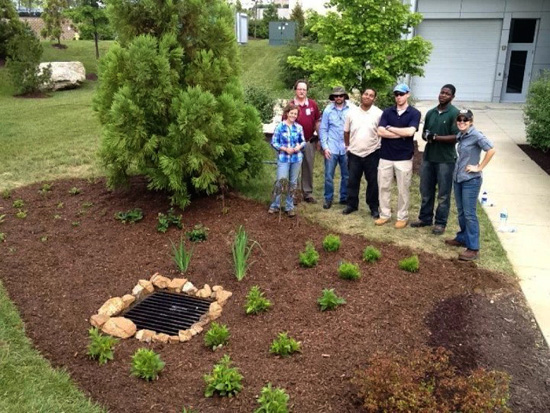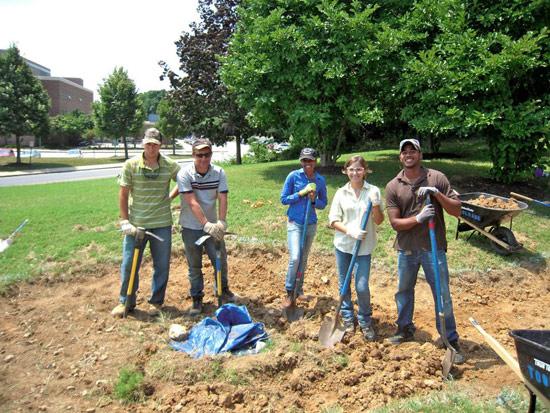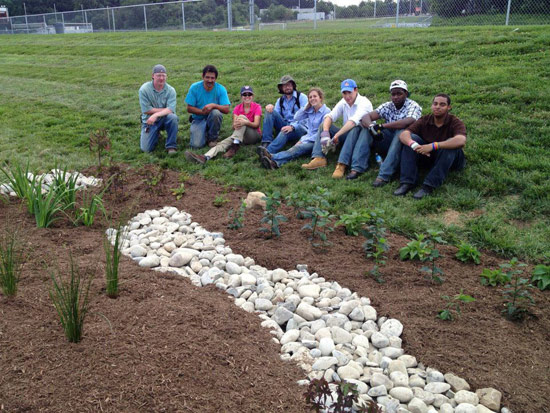Building rain gardens with youth in Howard County, Maryland
Thirty young people spent the summer building rain gardens. This is their story.
When Marcus Moody hears the term “rain garden,” he will smile. Not because those colorful patches of flood-tolerant plants capture stormwater and allow it to gradually sink into the ground, but because he survived seven weeks of planting 27 rain gardens in Howard County, Md., during the hottest summer on record.
For Marcus and the 29 other 16 to 25-year-olds that participated in the Restoring the Environment and Developing Youth program this summer, also known as READY, rain gardens are no longer an intangible concept or an idea to read about in guides to “going green.” Instead, rain gardens are dirty, wet and empowering endeavors that prove that a group of focused youth can make visible, lasting change. And in most cases, rain gardens are a lot of fun to create.
“We all became friends,” said Moody. “The actual experience of … getting to know new people and working in teams with different personalities—that was great.”
READY’s participants included graduate students, fashion design majors and high school seniors looking to fund their college careers. The program provided them with a resume-building career experience, a few extra dollars and a new network of friends.
Working with people from different backgrounds toward a common goal made the summer experience stand out for Afua Boateng, who moved to Maryland from Ghana six years ago.
"Sometimes I find myself thinking about things that I feel like no one in my age group thinks about, because [in Ghana] we are trained to grow up faster. Learning to work with people that have the same interest and that are willing to work together to save something we should all care about—I really love that,” Boateng said.

READY was conceived with two goals in mind: first, to provide jobs for young people. Second, to reduce the amount of stormwater runoff entering the Chesapeake Bay.
Stormwater runoff, or rainfall that picks up pollutants as it flows across paved roads, parking lots, lawns and golf courses, is the fastest growing source of pollution into the Bay. But rain gardens and other so-called best management practices can reduce the flow of stormwater into creeks, streams and rivers.
For Amanda Tritinger, building rain gardens brought her studies about stormwater to life.
"I studied hydrology and hydraulics as a course in school, but the theoretical doesn't stick with me at all and I don't really get it,” Tritinger said. “Seeing all this stuff hands-on was so valuable for me.”

READY is the brain child of People Acting Together in Howard (PATH), a coalition of faith-based organizations in Howard County, Md. READY is funded through a grant from the Howard County government administered by the Alliance for the Chesapeake Bay.
Like any program in its inaugural year, the leaders behind READY have learned lessons for next summer, with a number of suggestions coming from the participants themselves.
For Nabil Morad, who is enrolled in the Environmental Scholars Program at the University of Maryland, working in an environment where his feedback was valued was highly encouraging. It was also the last thing he expected from a program with the words "developing youth" in its title.
"I was a little worried we were going to be treated like kindergarteners," Nabil said. "But this feels like it's an actual job."
After working in an industry where his age and experience meant his suggestions were not welcome, Nabil said that READY's willingness to listen to its participants is refreshing.
“Here, respect travels both ways in the system. I could make a suggestion to [program manager] Don [Tsusaki], and if the day comes, he'll put it into action,” Nabil added. “Everybody here is developing toward the same goal together, which is really nice.”
That goal—curbing stormwater pollution—will become more attainable if READY continues in Howard County, and if similar programs are established elsewhere in the Bay watershed.
"We have a waiting list of people who want rain gardens for next year," said PATH administrator Guy Moody. "That's a good problem to have."

How do rain gardens help the Chesapeake Bay?
When rainfall hits impervious surfaces like sidewalks, roofs or driveways, or when it falls onto grass lawns, it is not absorbed into the ground. Instead, it runs off into a storm drain, collecting fertilizer, pesticides, pet waste, litter and other pollutants on its way.
Rain gardens are shallow depressions planted with sedges, rushes and other flood-tolerant vegetation that capture rainfall and allow it to soak slowly into the ground.
To learn how to install a rain garden on your property, visit Anne Arundel County’s Rainscaping page.

Comments
There are no comments.
Thank you!
Your comment has been received. Before it can be published, the comment will be reviewed by our team to ensure it adheres with our rules of engagement.
Back to recent stories